A Wideband Reflectarray Antenna for Satellite Application with Low Cross-Polarization
Abstract
:1. Introduction
2. Unit Cell Structure and Characterization
3. Reflectarray Antenna Implementation and Results
4. Conclusions
Author Contributions
Funding
Institutional Review Board Statement
Informed Consent Statement
Data Availability Statement
Conflicts of Interest
References
- Huang, J.; Encinar, J.A. Reflectarray Antennas, Institute of Electrical and Electronics Engineers; Wiley: Hoboken, NJ, USA, 2008. [Google Scholar]
- Waterhouse, R. Printed Antennas for Wireless Communications; Wiley: Hoboken, NJ, USA, 2007. [Google Scholar]
- Han, C.; Zhang, Y.; Yang, Q. A Novel Single-Layer Unit Structure for Broadband Reflectarray Antenna. IEEE Antennas Wirel. Propag. Lett. 2017, 16, 681–684. [Google Scholar] [CrossRef]
- Han, C.; Zhang, Y.; Yang, Q. A Broadband Reflectarray Antenna Using Triple Gapped Rings With Attached Phase-Delay Lines. IEEE Trans. Antennas Propag. 2017, 65, 2713–2717. [Google Scholar] [CrossRef]
- Liu, Y.; Wang, H.; Xue, F.; Dong, X. A novel single-layer reflectarray antenna using square spiral element. In Proceedings of the 2017 IEEE International Symposium on Antennas and Propagation & USNC/URSI National Radio Science Meeting, San Diego, CA, USA, 9–14 July 2017; pp. 95–96. [Google Scholar]
- Xue, F.; Wang, H.; Yi, M.; Liu, G.; Dong, X. Design of a Broadband Single-Layer Linearly Polarized Reflectarray Using Four-Arm Spiral Elements. IEEE Antennas Wirel. Propag. Lett. 2016, 16, 696–699. [Google Scholar] [CrossRef]
- Vosoogh, A.; Keyghobad, K.; Khaleghi, A.; Mansouri, S. A high-efficiency Ku-band reflectarray antenna using single-layer multiresonance elements. IEEE Antennas Wirel. Propag. Lett. 2014, 14, 891–894. [Google Scholar] [CrossRef]
- Qin, P.Y.; Guo, Y.J.; Weily, A.R. Broadband reflectarray antenna using subwavelength elements based on double square meander-line rings. IEEE Trans. Antennas Propag. 2015, 64, 378–383. [Google Scholar] [CrossRef]
- Xue, F.; Wang, H.J.; Yi, M.; Liu, G. A broadband KU-band microstrip reflectarray antenna using single-layer fractal elements. Microw. Opt. Technol. Lett. 2016, 58, 658–662. [Google Scholar] [CrossRef]
- Florencio, R.; Encinar, J.A.; Boix, R.R.; Losada, V.; Toso, G. Reflectarray antennas for dual polarization and broadband telecom satellite applications. IEEE Trans. Antennas Propag. 2015, 63, 1234–1246. [Google Scholar] [CrossRef] [Green Version]
- Guo, L.; Tan, P.K.; Chio, T.H. Bandwidth improvement of reflectarrays using single-layered double concentric circular ring elements on a subwavelength grid. Microw. Opt. Technol. Lett. 2014, 56, 418–421. [Google Scholar] [CrossRef]
- Yoon, J.H.; Kim, J.S.; Yoon, Y.J.; Lee, W.S.; So, J.H. Single-layer reflectarray with combination of element types. Electron. Lett. 2014, 50, 574–576. [Google Scholar] [CrossRef]
- Wang, X.; Huang, X.; Jin, X.; Cheng, C. Gain enhancement for low cost planar reflectarray antenna using hybrid elements. Int. J. RF Microw. Comput. Aided Eng. 2020, 30, e22204. [Google Scholar] [CrossRef]
- Bodur, H.; Cimen, S. Reflectarray antenna design with double cutted ring element for X-band applications. Microw. Opt. Technol. Lett. 2020, 62, 3248–3254. [Google Scholar] [CrossRef]
- Bodur, H.; Unaldi, S.; Cimen, S.; Cakir, G. Broadband single-layer reflectarray antenna for X-band applications. Microw. Antennas Propag. 2018, 12, 1609–1612. [Google Scholar] [CrossRef]
- Veluchamy, L.; Alsath, M.G.N.; Selvan, K.T. Design and evaluation of a wideband reflectarray antenna using cross dipole with double-ring elements. Int. J. RF Microw. Comput. Eng. 2019, 29, e21865. [Google Scholar] [CrossRef]
- Ozturk, E.; Saka, B. Multilayer Minkowski Reflectarray Antenna with Improved Phase Performance. IEEE Trans. Antennas Propagat. 2021, 69, 8961–8966. [Google Scholar] [CrossRef]
- Guo, L.; Yu, H.; Che, W.; Yang, W. A Broadband Reflectarray Antenna Using Single-Layer Rectangular Patches Embedded with Inverted L-Shaped Slots. IEEE Trans. Antennas Propag. 2019, 67, 3132–3139. [Google Scholar] [CrossRef]
- Min, M.; Guo, L. Design of a wideband single-layer reflectarray antenna using slotted rectangular patch with concave arms. IEEE Access 2019, 7, 176197–176203. [Google Scholar] [CrossRef]
- Li, X.; Luo, Y.; Wei, G.; Yi, X. A novel single layer wideband reflectarray design using two degrees of freedom elements. IEEE Trans. Antennas Propag. 2021, 69, 5095–5099. [Google Scholar] [CrossRef]
- Zhao, J.; Fu, C.; Li, H.; Li, F.; Hu, X. A Single-Layer Broadband Ka-Band Reflectarray Using Novel Windmill Elements. IEEE Trans. Antennas Propag. 2022, 70, 11167–11171. [Google Scholar] [CrossRef]
- Guo, M.; Guo, L.; Feng, W.; Chen, X. A Single-Layered Broadband Reflectarray Employing 0.15-Wavelength Elements. IEEE Antennas Wirel. Propag. Lett. 2022, 22, 318–322. [Google Scholar] [CrossRef]
- Malfajani, R.S.; Atlasbaf, Z. Design and implementation of a broadband single-layer reflectarray antenna with large-range linear phase elements. IEEE Antennas Wirel. Propag. Lett. 2012, 11, 1442–1445. [Google Scholar] [CrossRef]
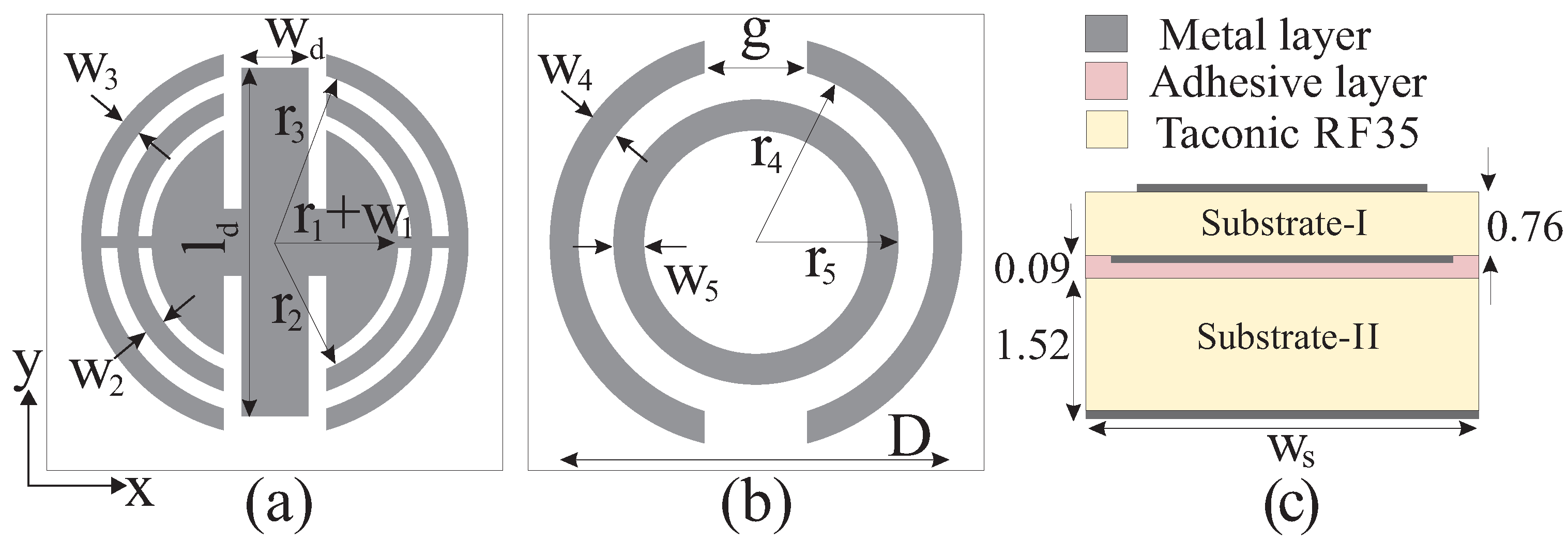
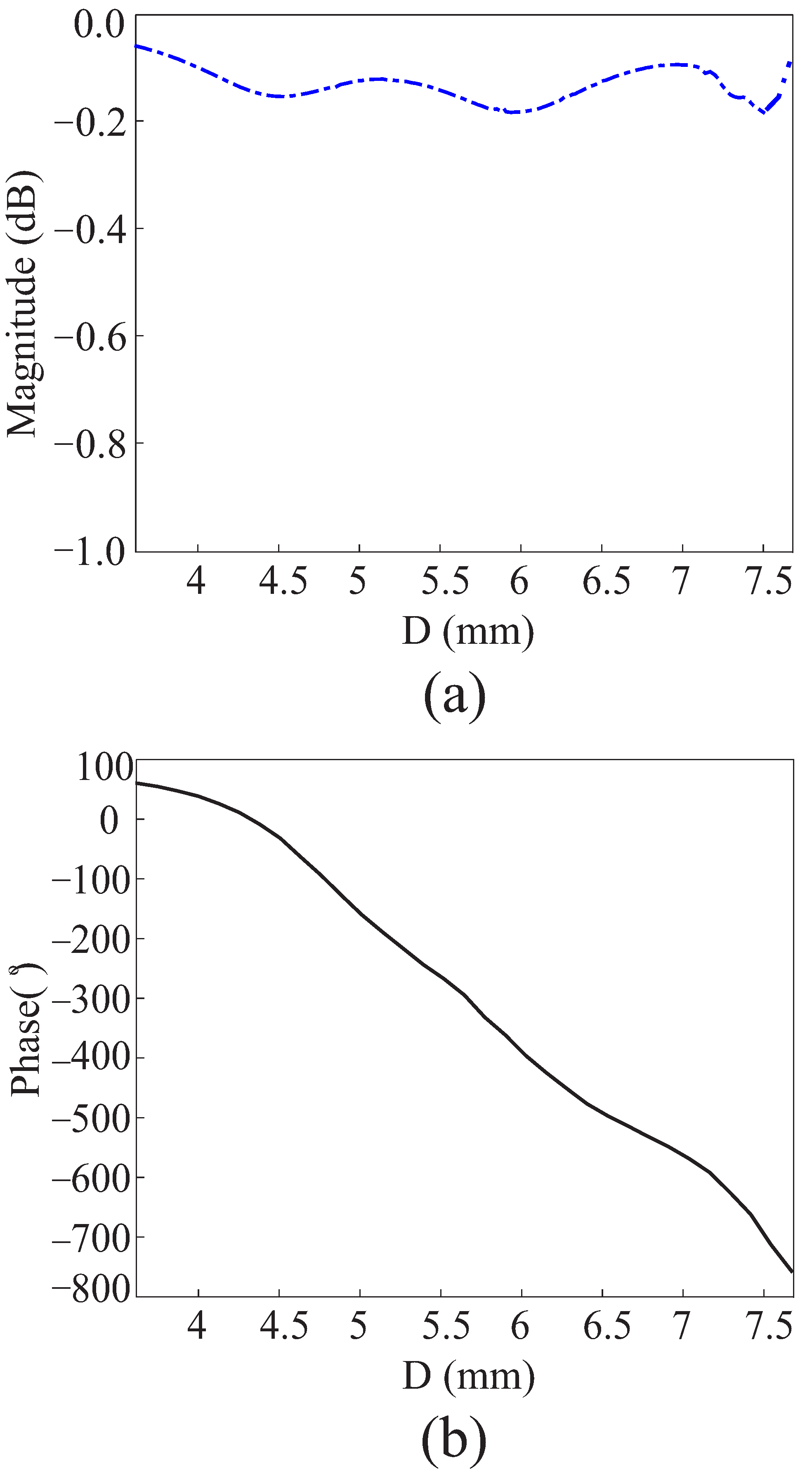

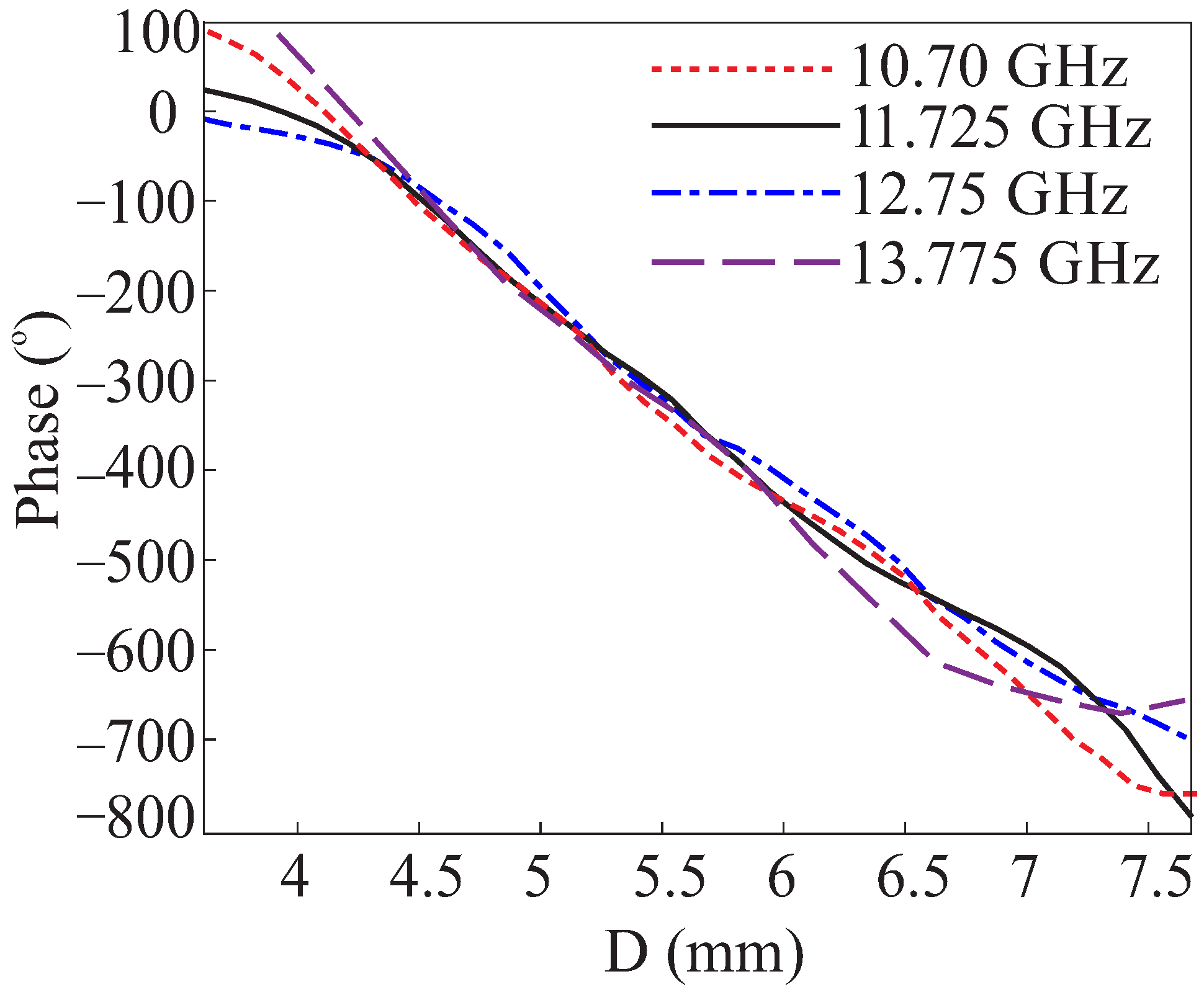
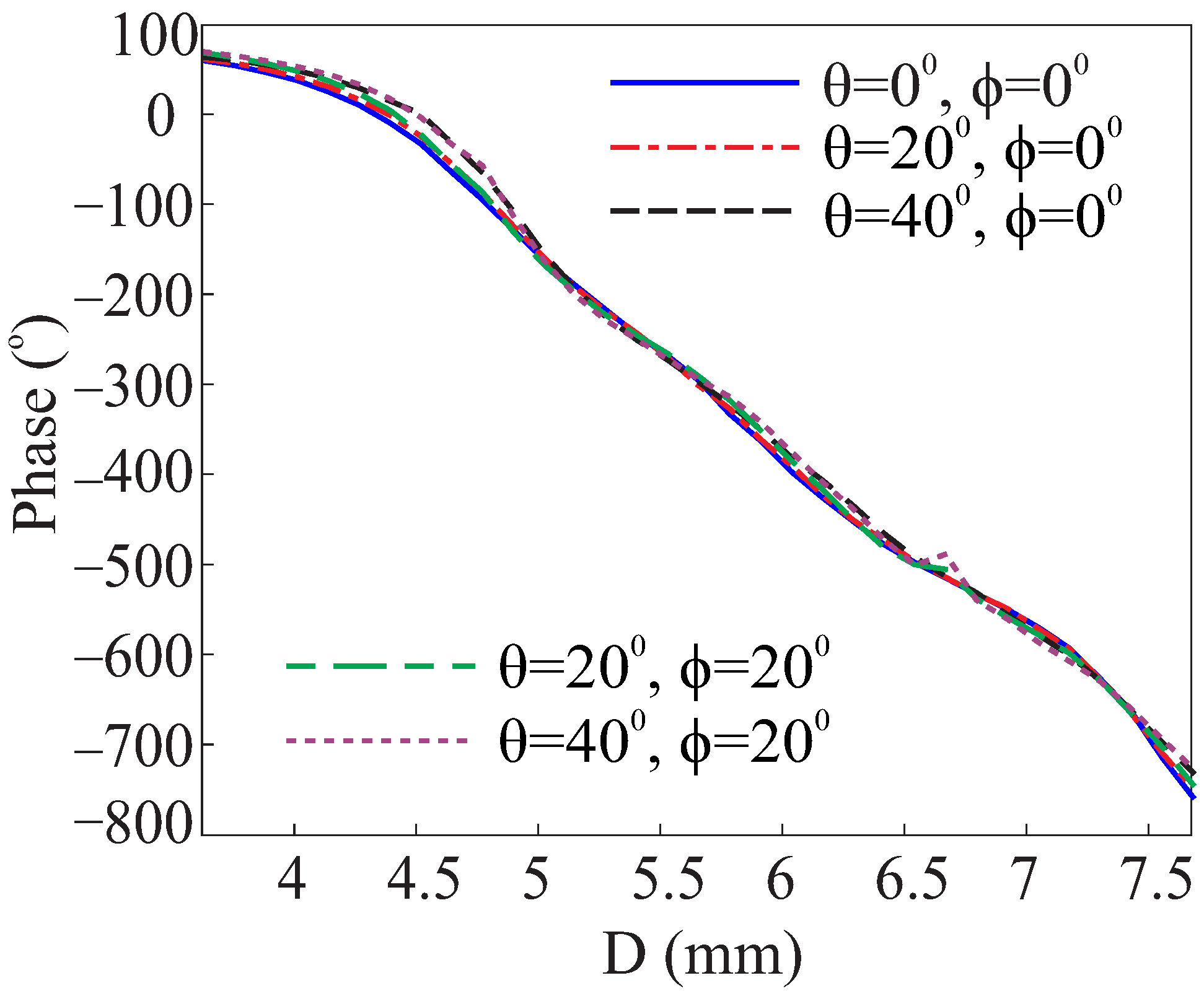
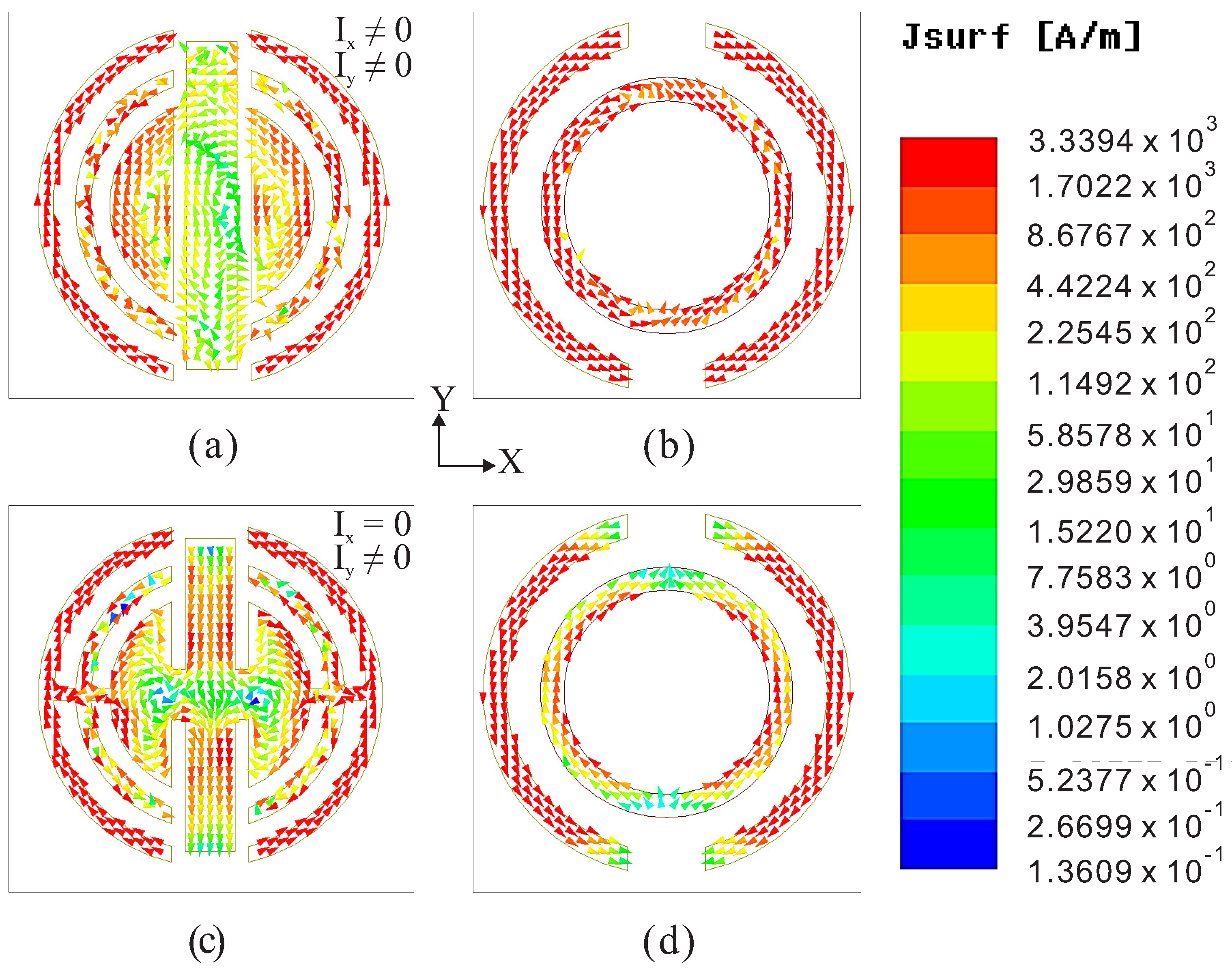


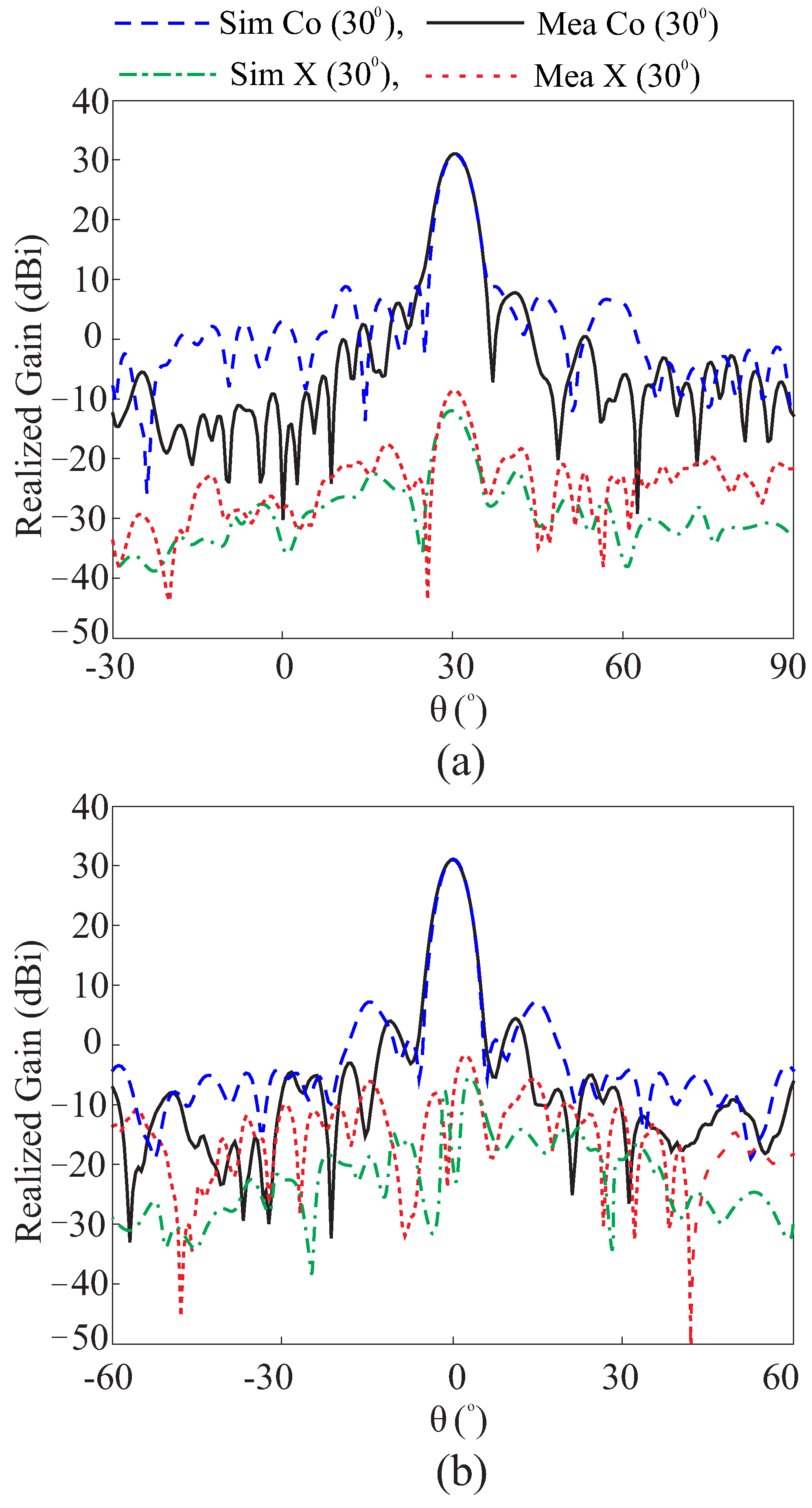

| [Ref] | Freq. (GHz) | Area () | F/D | (%) | GBW (%) | Co-Pol Gain (dBi) | X-Pol Level (dB) | SLL (E-, H-Plane (dB) |
|---|---|---|---|---|---|---|---|---|
| [3] | 10 | 9.5 × 9.5 | 0.79 | 51.3 | 20 (1 dB) | 26.3 | −26 | −17, −10 |
| [6] | 13.58 | 9.5 × 9.5 | 1 | 60.2 | 28.1 (1 dB) | 28.35 | −27.5 | −20, −20 |
| [7] | 13.5 | 14.4 × 14.4 | 0.83 | 66 | 17 (1 dB) | 30.8 | −27 | −25, - |
| [8] | 10 | 9.6 × 9.6 | 1 | 56.5 | 18 (1 dB), 32 (3 dB) | 28.5 | −30 | −12, −18 |
| [9] | 13.58 | 14.7 × 14.7 | 0.8 | - | 15.3 (1 dB) | 29.8 | −35 | −18.8, - |
| [11] | 10 | 14.3 × 14.3 | - | 39.8 | 24.2 (2 dB) | 29.17 | −30 | −15, - |
| [18] | 10 | 6.9 × 6.9 | 0.79 | 67 | 23 (1 dB) | 25.6 | −26 | −19, - |
| [20] | 8 | 8 × 8 | 1 | 55 | 35 (1 dB) | 26.5 | −30 | −14, - |
| [21] | 35 | 9.3 × 9.3 | 0.77 | – | 35 (3dB) | 27.86 | −25 | −17.93, - |
| Prop. | 11.725 | 17.8 × 17.8 | 0.765 | 41 | 32 (3 dB), 25.2 (1 dB) | 31.2 | −40 | −25, −28 |
Disclaimer/Publisher’s Note: The statements, opinions and data contained in all publications are solely those of the individual author(s) and contributor(s) and not of MDPI and/or the editor(s). MDPI and/or the editor(s) disclaim responsibility for any injury to people or property resulting from any ideas, methods, instructions or products referred to in the content. |
© 2023 by the authors. Licensee MDPI, Basel, Switzerland. This article is an open access article distributed under the terms and conditions of the Creative Commons Attribution (CC BY) license (https://creativecommons.org/licenses/by/4.0/).
Share and Cite
Elahi, M.; Jeong, T.; Yang, Y.; Lee, K.-Y.; Hwang, K.C. A Wideband Reflectarray Antenna for Satellite Application with Low Cross-Polarization. Appl. Sci. 2023, 13, 4545. https://doi.org/10.3390/app13074545
Elahi M, Jeong T, Yang Y, Lee K-Y, Hwang KC. A Wideband Reflectarray Antenna for Satellite Application with Low Cross-Polarization. Applied Sciences. 2023; 13(7):4545. https://doi.org/10.3390/app13074545
Chicago/Turabian StyleElahi, Manzoor, Taeyong Jeong, Youngoo Yang, Kang-Yoon Lee, and Keum Cheol Hwang. 2023. "A Wideband Reflectarray Antenna for Satellite Application with Low Cross-Polarization" Applied Sciences 13, no. 7: 4545. https://doi.org/10.3390/app13074545






